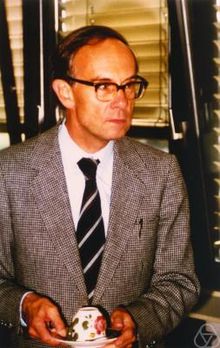Friedrich Hirzebruch
Friedrich Hirzebruch | |
|---|---|
 Friedrich Hirzebruch in 1980 (picture courtesy MFO) | |
| Born | Friedrich Ernst Peter Hirzebruch 17 October 1927 |
| Died | 27 May 2012 (aged 84) |
| Nationality | German |
| Alma mater | |
| Known for | |
| Awards |
|
| Scientific career | |
| Fields | Mathematics |
| Institutions | |
| Doctoral advisor | |
| Doctoral students | |
Friedrich Ernst Peter Hirzebruch ForMemRS[1] (17 October 1927 – 27 May 2012) was a German mathematician, working in the fields of topology, complex manifolds and algebraic geometry, and a leading figure in his generation. He has been described as "the most important mathematician in Germany of the postwar period."[3][4][5][6][7][8][9][10][11]
Education
Hirzebruch was born in Hamm, Westphalia in 1927.[12] He studied at the University of Münster from 1945–1950, with one year at ETH Zürich.
Career
Hirzebruch then held a position at Erlangen, followed by the years 1952–54 at the Institute for Advanced Study in Princeton, New Jersey. After one year at Princeton University 1955–56, he was made a professor at the University of Bonn, where he remained, becoming director of the Max-Planck-Institut für Mathematik in 1981. More than 300 people gathered in celebration of his 80th birthday in Bonn in 2007.
The Hirzebruch–Riemann–Roch theorem (1954) for complex manifolds was a major advance and quickly became part of the mainstream developments around the classical Riemann–Roch theorem; it was also a precursor of the Atiyah–Singer index theorem. Hirzebruch's book Neue topologische Methoden in der algebraischen Geometrie (1956) was a basic text for the 'new methods' of sheaf theory, in complex algebraic geometry. He went on to write the foundational papers on topological K-theory with Michael Atiyah, and collaborate with Armand Borel on the theory of characteristic classes. In his later work he provided a detailed theory of Hilbert modular surfaces, working with Don Zagier.
In March 1945, Hirzebruch became a soldier, and in April, in the last weeks of Hitler's rule, he was taken prisoner by the British forces then invading Germany from the west. When a British soldier found that he was studying mathematics, he drove him home and released him, and told him to continue studying.[1]
Hirzebruch died at the age of 84 on 27 May 2012.[13][14][15]
Honours and awards
Amongst many other honours, Hirzebruch was awarded a Wolf Prize in Mathematics in 1988 and a Lobachevsky Medal in 1989.[16]
The government of Japan awarded him the Order of the Sacred Treasure in 1996.[17]
Hirzebruch won an Einstein Medal in 1999, and received the Cantor medal in 2004.
Hirzebruch was a foreign member of numerous academies and societies, including the United States National Academy of Sciences, the Russian Academy of Sciences, the Royal Society[1] and the French Academy of Sciences. In 1980–81 he delivered the first Sackler Distinguished Lecture in Israel.
References
- ^ a b c Atiyah, Michael (2014). "Friedrich Ernst Peter Hirzebruch 17 October 1927 — 27 May 2012". Biographical Memoirs of Fellows of the Royal Society. Royal Society. doi:10.1098/rsbm.2014.0010.
- ^ Friedrich Hirzebruch at the Mathematics Genealogy Project
- ^ "Friedrich Hirzebruch 1927-2012". 29 May 2012. Retrieved 29 May 2012.
- ^ Europa Publications (2003). The International Who's Who 2004. Routledge. ISBN 978-1-85743-217-6. Retrieved 24 April 2010.
- ^ Hirzebruch, Friedrich; Mayer, Karl Heinz (1968), O(n)-Mannigfaltigkeiten, Exotische Sphären und Singularitäten, Lecture Notes in Mathematics, vol. 57, Berlin, New York: Springer-Verlag, doi:10.1007/BFb0074355, MR 0229251
- ^ Hirzebruch, Friedrich; Zagier, Don (1974), The Atiyah-Singer theorem and elementary number theory, Houston, TX: Publish or Perish, MR 0650832
- ^ Hirzebruch, Friedrich (1987), Gesammelte Abhandlungen. Band I, II, Berlin, New York: Springer-Verlag, ISBN 978-3-540-18087-6, MR 0931775
- ^ Hirzebruch, Friedrich; Jung, Rainer; Berger, Thomas (1992), Manifolds and modular forms, Aspects of Mathematics, E20, Braunschweig: Friedr. Vieweg & Sohn, ISBN 978-3-528-06414-3, MR 1189136
- ^ Hirzebruch, Friedrich (1995) [1956], Topological methods in algebraic geometry, Classics in Mathematics, Berlin, New York: Springer-Verlag, ISBN 978-3-540-58663-0, MR 1335917
- ^ Segel, Joel (2011-12-01). "Friedrich Hirzebruch: Giant of German Mathematics". Simons Foundation.
- ^ Atiyah, Michael; Zagier, Don (2014), "Friedrich Hirzebruch (1927–2012)" (PDF), Notices of the American Mathematical Society, 61 (7): 706–727, doi:10.1090/noti1145
- ^ O'Connor, John J.; Robertson, Edmund F., "Friedrich Hirzebruch", MacTutor History of Mathematics Archive, University of St Andrews
- ^ "With great sadness we mourn the death of our founder, Friedrich Hirzebruch, who passed away on Sunday, May 27". Max Planck Institute for Mathematics.
- ^ Max Planck Institute Announcement, Max Planck Institute for Mathematics. Retrieved on 29 May 2012.
- ^ "Friedrich Hirzebruch, Mathematician, Is Dead at 84"
- ^ Schecter, Bruce (June 10, 2012), "Friedrich Hirzebruch, Mathematician, Is Dead at 84", The New York Times
- ^ L'Harmattan web site (in French), Order with gold and silver rays
- 1927 births
- 2012 deaths
- Albert Einstein Medal recipients
- Algebraic geometers
- Foreign Members of the Royal Society
- Foreign Members of the Russian Academy of Sciences
- German mathematicians
- Knight Commanders of the Order of Merit of the Federal Republic of Germany
- Members of the French Academy of Sciences
- Members of the United States National Academy of Sciences
- People from Hamm
- People from the Province of Westphalia
- Recipients of the Order of the Sacred Treasure
- Recipients of the Pour le Mérite (civil class)
- University of Münster alumni
- University of Erlangen-Nuremberg faculty
- University of Bonn faculty
- Wolf Prize in Mathematics laureates
- German military personnel of World War II
